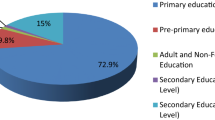Abstract
South Asia, with a quarter of the world’s population, has at least a quarter of the world’s children who should be in primary school but are not. As a region, South Asia will almost certainly fall short of achieving the second EFA goal by 2015: full access to, and completion of, primary education. What can be done now to improve the prospects of achieving the goal as soon after 2015 as possible and to lay a solid foundation for doing so?
Similar content being viewed by others
Notes
The Consortium for Research on Educational Access, Transition and Equity (CREATE) postulated various “zones of exclusion”, corresponding to different forms of exclusion from education and categories of children affected by clusters of exclusionary factors (Lewis 2007).
References
Ahmed, M. (2009). The education challenges: Priorities for the Sixth Plan. Background paper prepared for the Sixth Plan. Dhaka: Bangladesh Institute of Development Studies.
Ahmed, M., Ahmed, K. S., Khan, N. I., & Ahmed, R. (2007). Access to education in Bangladesh: Country analytic review of primary and secondary education. CREATE Country Analytic Review. Brighton: University of Sussex.
Aslam, M. (2007). The relative effectiveness of government and private schools in Pakistan: Are girls worse off? RECOUP Working Paper 4. Oxford: Oxford University.
Government of India (2001). National Census Statistics. http://censusindia.gov.in/Tables_Published/SCST/scst_main.html.
Govinda, R., & Bandyopadhyay, M. (2008). Access to elementary education in India: Country analytical review. CREATE Pathways to Access Series. New Delhi and Brighton: CREATE-NUEPA. http://www.create-rpc.org/pdf_documents/India_CAR.pdf.
Lewin, K. (2007). Improving access, equity and transitions in education: Creating a research agenda. CREATE Pathways to Access Series, No. 1. Brighton: CREATE.
Pratham. (2007). Annual status of education report (rural) 2006. New Delhi: Pratham. http://pib.nic.in/release/release.asp?relid=23947&kwd=.
Sandkull, O. (2005). Strengthening inclusive education by applying a rights-based approach to education programing. Bangkok: UNESCO.
Tilak, J. (2010). On the Right to Education Act. [Posting on the National Forum of India on yahoogroups.co.in]. http://educationworldonline.net/index.php/page-article-choice-more-id-2288.
Tomasevski, K. (2004). Manual on rights-based education. Bangkok: UNESCO.
UNESCO. (2008). South and West Asia regional overview. Background paper for EFA Global Monitoring Report 2008. Paris: UNESCO.
UNESCO & UNICEF. (2007). A human rights-based approach to Education for All. New York and Paris: UNICEF and UNESCO.
Venkataith, S. (1999). Adult and modern education. In S. Venkataith (Ed.), Encyclopedia of contemporary education (pp. 67–68). New Delhi: Anmol Publications.
Author information
Authors and Affiliations
Corresponding author
About this article
Cite this article
Ahmed, M., Govinda, R. Introduction. Prospects 40, 321–335 (2010). https://doi.org/10.1007/s11125-010-9165-3
Published:
Issue Date:
DOI: https://doi.org/10.1007/s11125-010-9165-3




